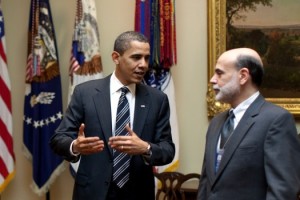Sign up before Midnight to watch our video,
“Biggest Ponzi Scheme in U.S. History to Crash,”
and get our daily e-letter Investment Contrarians.
We respect your privacy!
We will never rent/sell your e-mail address.
That’s a promise! And you can opt out at any time.

You can thank the reckless money printing that the Federal Reserve has been doing for the incredible bull market that we have seen in recent months. When the Federal Reserve does more "quantitative easing", it is the financial markets that benefit the most. The Dow and the S&P 500 have both hit levels not seen since 2007 this month, and many analysts are projecting that 2013 will be a banner year for stocks. But is a rising stock market really a sign that the overall economy is rapidly improving as many are suggesting? Of course not. Just because the Federal Reserve has inflated another false stock market bubble with a bunch of funny money does not mean that the U.S. economy is in great shape. In fact, the truth is that things just keep getting worse for average Americans. The percentage of working age Americans with a job has fallen from 60.6% to 58.6% while Barack Obama has been president, 40 percent of all American workers are making $20,000 a year or less, median household income has declined for four years in a row, and poverty in the United States is absolutely exploding. So quantitative easing has definitely not made things better for the middle class. But all of the money printing that the Fed has been doing has worked out wonderfully for Wall Street. Profits are soaring at Goldman Sachs and luxury estates in the Hamptons are selling briskly. Unfortunately, this is how things work in America these days. Our "leaders" seem far more concerned with the welfare of Wall Street than they do about the welfare of the American people. When things get rocky, their first priority always seems to be to do whatever it takes to pump up the financial markets.
When QE3 was announced, it was heralded as the grand solution to all of our economic problems. But the truth is that those running things knew exactly what it would do. Quantitative easing always pumps up the financial markets, and that overwhelmingly benefits those that are wealthy. In fact, a while back a CNBC article discussed a very interesting study from the Bank of England which showed a clear correlation between quantitative easing and rising stock prices...
When QE3 was announced, it was heralded as the grand solution to all of our economic problems. But the truth is that those running things knew exactly what it would do. Quantitative easing always pumps up the financial markets, and that overwhelmingly benefits those that are wealthy. In fact, a while back a CNBC article discussed a very interesting study from the Bank of England which showed a clear correlation between quantitative easing and rising stock prices...
It said that the Bank of England’s policies of quantitative easing – similar to the Fed’s – had benefited mainly the wealthy.Specifically, it said that its QE program had boosted the value of stocks and bonds by 26 percent, or about $970 billion. It said that about 40 percent of those gains went to the richest 5 percent of British households.Many said the BOE's easing added to social anger and unrest. Dhaval Joshi, of BCA Research wrote that “QE cash ends up overwhelmingly in profits, thereby exacerbating already extreme income inequality and the consequent social tensions that arise from it."
So should we be surprised that stocks are now the highest that they have been in more than 5 years?
Of course not.
And who benefits from this?
The wealthy do. In fact, 82 percent of all individually held stocks are owned by the wealthiest 5 percent of all Americans.
Unfortunately, all of this reckless money printing has a very negative impact on all the rest of us. When the Fed floods the financial system with money, that causes inflation. That means that the cost of living has gone up even though your paycheck may not have.
If you go to the supermarket frequently, you know exactly what I am talking about. The new "sale prices" are what the old "regular prices" used to be. They keep shrinking many of the package sizes in order to try to hide the inflation, but I don't think many people are fooled. Our food dollars are not stretching nearly as far as they used to, and we can blame the Federal Reserve for that.
For much more on rising prices in America, please see this article: "Somebody Should Start The ‘Stuff Costs Too Much’ Party".
Sadly, this is what the Federal Reserve does. The system was designed to create inflation. Before the Federal Reserve came into existence, the United States never had an ongoing problem with inflation. But since the Fed was created, the United States has endured constant inflation. In fact, we have come to accept it as "normal". Just check out the amazing chart in the video posted below...
Sign up before Midnight to watch our video,
“Biggest Ponzi Scheme in U.S. History to Crash,”
and get our daily e-letter Investment Contrarians.
We respect your privacy!
We will never rent/sell your e-mail address.
That’s a promise! And you can opt out at any time.